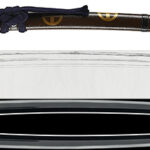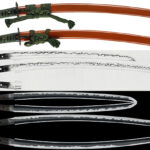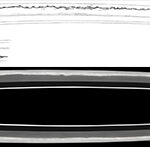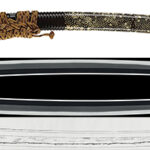Ordering number:24413
Katana in Shirasaya (NBTHK Hozon Token)
Signature: Mumei (Kaifu)
無銘(海部)
We divide 4 sections for each sword as Saijyo Saku, Jyojyo Saku, Jyo Saku, and Regular Saku. This work is ranked as Jyo Saku for Mumei (Kaifu).
Polished.
Habaki: Plain copper, single layer.
Blade Length: 70.3 cm (27.68 in)
Curvature: 1.2 cm (0.47 in)
Mekugi Holes: 2
Width at Base: 2.99 cm (1.18 in)
Width at Yokote: 2.06 cm (0.81 in)
Thickness of Rim (Kasane): 0.67 cm (0.26 in)
Sword Weight: 800 g (1.76 lbs)
Era: Late Muromachi Period.
Shape: Wide blade with thick kasane and extended kissaki.
Jigane: Well-forged itame-hada with visible grain pattern.
Hamon: Straight temper line with ashi (small feet) entering, and some areas where the hamon appears misty.
Boshi: Notare (wave-shaped) with a small rounded return.
Features: This is a well-balanced piece with a good length and an extended kissaki.
Aoi Art’s Comment: Kaifu works are known for their prominent grain patterns, giving them an ancient appearance. On shorter blades like wakizashi and tanto, they often feature signatures such as "海部 Kaifu" or "買部 Kaifu." Longer swords like this one are rare and valuable. The Amafu group is linked to Kaifu District in Awa Province, which is now part of modern-day Kaifu District, Tokushima Prefecture. This region, at the southern tip of Awa, served as a defensive line against Tosa Province. The Kaifu smiths are thought to have emerged during the late Nanbokucho period. Although many of their works are attributed to the Nanbokucho to early Muromachi periods, this particular sword seems to date from the late Muromachi period. The grainy texture of the jigane is typical of this school, evoking the power of the pirates who once roamed the Seto Inland Sea.
Historical Background: The late Muromachi period saw numerous battles, including in the southern tip of Awa Province. Kaifu smiths produced swords highly valued by warriors for their cutting ability. While signed wakizashi and tanto are common, longer katana are rare, making this an excellent recommendation.
NBTHK Hozon Token
Aoi Art Estimation Paper
Whole Oshigata
Price:350,000JPY
商談中 HOLD
Related Items:
 Katana: Kiyomitsu(Kashu)with Saidanmei(NBTHK Hozon Token)
Katana: Kiyomitsu(Kashu)with Saidanmei(NBTHK Hozon Token)
 Daisho: Yozayemon Jo Sukesada & Harima Daijo Tadakuni (NBTHK Certificates)
Daisho: Yozayemon Jo Sukesada & Harima Daijo Tadakuni (NBTHK Certificates)
 Katana: Bizen Koku Osafune Sukesada Saku Dated: 2nd Year of Genki, August (1572)(NBTHK Hozon Token)
Katana: Bizen Koku Osafune Sukesada Saku Dated: 2nd Year of Genki, August (1572)(NBTHK Hozon Token)
 Katana: Hida Kami Fujiwara Ujifusa(NBTHK Hozon Token)(Consignment Sale)
Katana: Hida Kami Fujiwara Ujifusa(NBTHK Hozon Token)(Consignment Sale)
 Katana: Hoki Kami Ason Masayuki
Katana: Hoki Kami Ason Masayuki
 Katana:Mumei (Den Aoe) (NBTHK Tokubetsu Hozon Token)
Katana:Mumei (Den Aoe) (NBTHK Tokubetsu Hozon Token)






